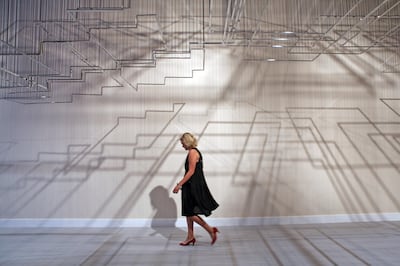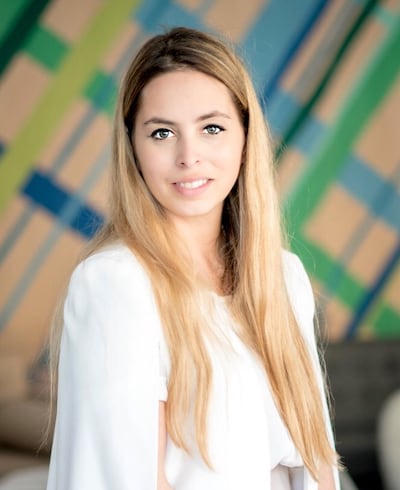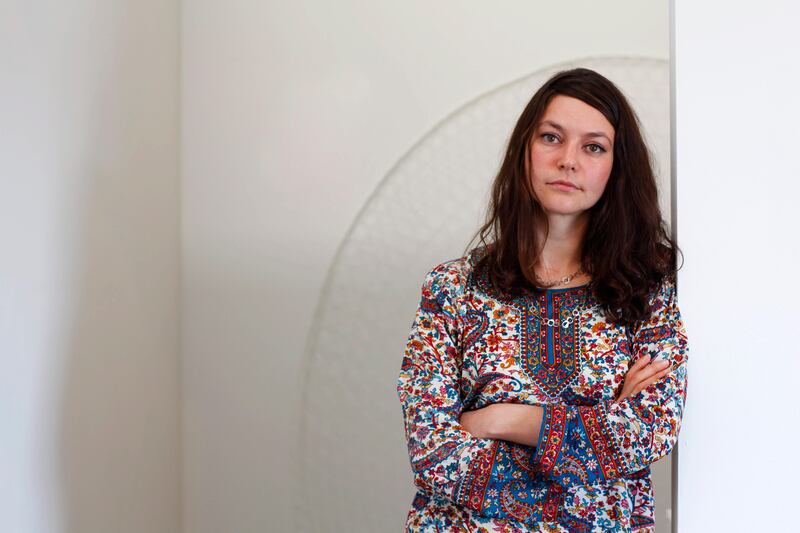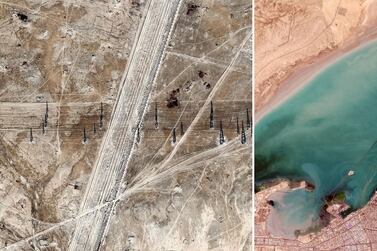Nadia Kaabi-Linke has been announced as the winner of this year’s Ithra Art Prize.
The Tunis-born artist, who also has Ukrainian roots and currently lives in Berlin, was chosen for the $100,000 award for her artwork proposal – a large-scale installation that takes the Covid-19 pandemic as its starting point to reflect on potential new futures for the people and the planet.
Her work will be unveiled at the Ad-Diriyah Biennale, Saudi Arabia’s first art biennial, which will be held from December to March 2022 outside of Riyadh.
The latest round of the Ithra Art Prize – granted by the Aramco-sponsored King Abdulaziz Centre for World Culture, also known as Ithra, in Dhahran, Saudi Arabia – comes with a few significant changes. For one, this year marks the first time that the prize will be given to a non-Saudi artist after Ithra expanded its open call to all artists from the Arab League, and not only those within the kingdom.
The previous winners of the Ithra Art Prize are Fahad bin Naif, Daniah Al Saleh and Ayman Zedani.
In addition, it will also be the first time that the winning work will be unveiled in Saudi Arabia, as all of the previous winners had initially been shown at Art Dubai. The change of location is the result of Ithra’s new collaboration with the Ad-Diriyah Biennale Foundation.
Kaabi-Linke’s work will be one of the highlights of the art event, which will take place at the site of the historic Salwa Palace, known for its distinctive architecture and as the original home of the Al Saud royal family.
In an interview with The National, the artist reveals that she had been thinking about the project for a year, even before the Ithra Art Prize. “It was a process that was happening in parallel, for its own sake, and I was pushing to realise it,” she says.

Kaabi-Linke’s previous works have included site-specific installations and large-scale prints that reflect on geopolitical issues on a very human level, at times drawing from stories of migrant street traders or victims of domestic violence, for example.
The artist features in the collections of the Museum of Modern Art (MoMA) and Solomon R Guggenheim Museum in the US, as well as the Centre Pompidou in France. In 2009, she was commissioned by Sharjah Art Foundation for the Sharjah Biennial 9, and two years later, won the Abraaj Group Art Prize.
Her artwork for the Ithra Art Prize will be a monumental structure that uses the standard symbol of growth, the rising arrow, albeit splintered in some form, to represent the economic disruption wrought by the pandemic.
Using marouflage, Kaabi-Linke will apply silk paper prints on to the surface of the structure. It is a delicate process that involves layering adhesive mixtures to transfer the prints, and made more challenging by the Ad-Diriyah site’s windy weather. The artist, however, says she is confident with the material, which she has been using for 15 years after being initially inspired by anti-dictatorship scrawls on the streets of Tunisia.
Working closely with her husband, Timo Kaabi-Linke – she muses that they operate as a “hidden collective” under her name – the artist says the idea for the work was inspired from experiences in her own life. As shutdowns and flights were cancelled worldwide owing to Covid-19, she reflected on an arrow painted on the ground of an airport close to her home, one that she had frequently used and even landed in on her arrival to Germany 15 years ago. It had become empty. “The whole airport became a metaphor for our time,” she says.
In the coming months, the artist will be working with Ithra’s curatorial team on the project before visiting the site for installation. Prior to that, she will be presenting an art intervention at Expo 2020 Dubai in October alongside other artists.
Candida Pestana, curator of contemporary art at Ithra, says that the team is also preparing for the storage and preservation of the artwork in the institution’s permanent collection after the biennial show, and its potential travel method for future exhibitions.
Speaking on Kaabi-Linke’s selection, made by a seven-member jury comprising regional and international figures in art, Pestana explains: “The project was most striking for its completion, conceptually, and the way it beautifully captures this moment… The jury also didn’t have any doubts about the quality and perfectionism of the artist, something that is very characteristic of Nadia.”

For her work, Kaabi-Linke is not only contemplating our present, but is looking towards the trajectory of a new future. The arrow, representing growth and acceleration, also opens up several translations. “It is important to state or create an iconic image about what we’re going through, but especially where we’re heading,” she says.
“It’s more about leaving our comfort zones and heading towards something together… What we know is that our current state is definitely not leading us to survival,” she continues. “With the symbol of the arrow, we want to represent something else – the possibility of exit.”
This exit, she explains, is a complete shift in worldview and world order. It is “exiting the individualistic, neoliberal world that we live in”, through various ways. “We have to consume differently. We really have to go back to what our ancestors did, to learn community living. We need to learn that we can survive only if we help the next generation,” she says.
While the pandemic and ever-growing urgency of climate change have spurred a “forced unity”, the artist says it is important not to ignore our diversity. “It’s not about giving up our differences and becoming a collective, but about making choices together… It also means that the models of nation-building and the interests of specific countries won’t work any more. We’re learning it day by day in politics, health, and environmental issues,” she explains.
It is an immense task, weighted more by the seeming urgency of global problems, but the artist feels assured in her role. “Artists have always been producing, and the most creative moments have always been the moments when there is a crisis, so in that sense, I am extremely optimistic. I think we are living in a privileged time of change and action,” she says.
“I never believed that the artist had a message to bring that will make people change. I think the art is there to move something within you, then you will take a step forward because of that inspiration,” Kaabi-Linke says. “Artists bring something that no other medium can bring. The space we occupy has to do with the soul, and the changes start there, when something is deeply moved within you. I think that’s my job.”







